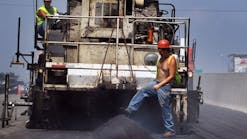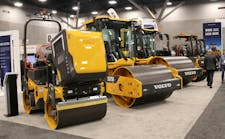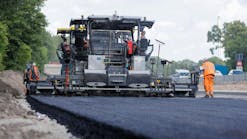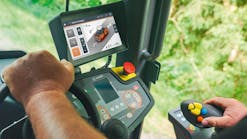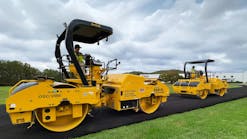How to Protect Paving Operators and Ground Crews
The larger the paving job, the more likely there may be a paving train present—a line of equipment and workers often working next to live traffic. These configurations carry with them unique safety concerns for managers, but individually, each piece also has its own safety challenges that can be mitigated by proper operation and maintenance, as well as by a properly trained and equipped crew.
It’s no surprise that paving-fleet safety begins with training. First, know what you’re operating and who is operating, says David Murray, a veteran safety and training consultant who has done work for the State of Nevada, among other entities.
Training goes a long way
“Obtain the operator’s manuals from the manufacturers or dealers and highlight and segment the specific safety points within it for new operator training and periodic refresher training for experienced operators,” Murray says.
In the manuals, note critical areas of safety concerns. Perform a walk-around on the equipment with the operator and related work crew: in a paving operation, the number of ground personnel can outnumber the equipment operators, and they need to return home safely, too.
“Manufacturers and dealers are required by OSHA standards to equip hazardous areas of the machine with easily visible safety warning signage,” Murray says. “This signage must be kept clean and legible. If the warning signage becomes stained with tar or oil grit, use diesel fuel or WD-40 to clean it. If you’re working in an area where diesel fuel isn’t allowed as a cleaner or degreaser because of environmental concerns, use a soap compound instead. Warning decals that are damaged or illegible need replacement.”
Murray also advises that the first time an operator is executing a paving job, have a veteran, competent operator train the new operator.
“Remember that manufacturers, dealers, trade unions, and vocational schools and colleges can be sourced for professional operator trainers for paving equipment that is either completely new to your fleet, or for refresher training of operators and crews,” he says. “Workers always enjoy seeing new faces on the job site providing helpful instruction.”
Down paving equipment and traffic hazards
A down piece of equipment on a paving operation is a safety hazard itself. Sound maintenance can keep equipment and associated operators and workers from becoming sitting ducks in high-traffic situations.
“Obtain the lubrication and maintenance manual for each machine from the manufacturer or dealer and establish a lubrication schedule and preventative maintenance and component repair-before-failure schedule,” Murray says. “Establish a database or document a historical record specific to each unit to record lubrication, maintenance, repairs, and major component replacement. Oil analysis of the engine is highly recommended to detect needed rebuild before failure and to perform scheduled maintenance and plan rebuild downtime.”
Recordkeeping is vital. Murray recommends recording daily safety and maintenance inspections and by-shift inspections in a simplified checklist, with an area for expanded detail of notable findings. “Also, develop a ready and easily accessible service parts list for air and fluid filters, metal wear, and common machine replacement items like mill hammers and bits, with preferred vendors.
“Maintain the required Safety Data Sheet, or SDS, reference manual for fluids such as solvents, hydraulic oil, and ‘liquid gasket,’ and also for any additive concrete chemicals and road materials applied to the paving materials on the paving train, and at the batch plant,” Murray says. “Maintain these data sheets at a location familiar and easily accessible to all team members. This is a major OSHA regulatory item.”
As for traffic, Murray says to be aware that each state has its own regulations pertaining to construction warning signage, reduced-speed zones, flagger requirements, and night operations. “Contact the local city, county or state road department for specific requirements,” he says.
“Safety personnel and flaggers require additional training for night operations,” Murray adds. “The new mobile and on-board lighting systems for night paving work have special maintenance requirements specific to the type of lighting unit—follow the manufacturer’s guidelines.”
Murray also stresses that managers need to plan for the unforeseen serious accident. “The set-up and maintenance of safety protocols in a paving zone is critical to preventing injuries and deaths,” Murray says. “And make sure you have complete first-aid kits in close proximity to paving equipment. You may have to administer first aid to an errant motorist who impacts a crew member or flagger, or crashes into the equipment.”
Equipment surfaces
Paving equipment typically has more workers walking around or standing on the machines than earthmoving machinery does. Pavers have designated areas for crew both near and away from the actual operator.
“Provide adequate ‘housekeeping’ on the equipment to ensure the operator’s floor deck is free of slippery materials and trash,” Murray says.
“Also, handrails, access stairs, floor pedals and control knobs must be free of tar, grease and oils. Working and walking surfaces on a machine like catwalks and ladders must be kept clean of excess asphalt, oils and cement,” he says.
“Steam-clean areas where there have been hydraulic leaks or accumulated excess grease after servicing or repairs to avoid a fire hazard. Lots of slip, trip and fall injuries can be avoided on paving equipment by simple daily housekeeping,” according to Murray.
Fire risks
Murray recommends equipping units with OEM- or vendor-installed fire-suppression systems due to the nature of hot asphalt materials alongside hydraulic hoses, rubber drive belts, and tires. Keep in mind that cutting and grinding asphalt is very hot work.
“Inspect your fire-suppression system on a scheduled basis per the fire-suppression-maker’s recommendations,” he says. “Maintain the system to ensure proper activation, and have portable fire extinguishers that are fully charged and regularly inspected in your service vehicles and pickup trucks—and have extinguishers close to the work area when performing welding repairs.”
Finally, provide emergency training to crews and operators so that they know how to respond in the event of a fire on the equipment or at a batch plant.
Air induction and electrical systems
Murray offers the following tips for these important systems.
- Inspect the air-induction system to ensure that all connections are tight and intact.
- Inspect the air intake area to ensure that it is free of dirt and paving material buildup.
- Periodically inspect the air filter service indicator to ensure that it is in the “green.” Some equipment has electronic sensors indicating the need to change the air filter change or provide air system service.
Paving operations generate a lot of noise and dust, which have their own inherent hazards. “In high-impact areas, particularly alongside the milling machine, have workers wear hearing protection,” Murray says.
“In constant, noisy, high-decibel areas with 80 dB(A) or above, crew members must use hearing protection. In addition, make sure that dust control and suppression equipment is properly functioning. For extremely dusty conditions where workers are in close proximity to the dust source, have workers tested, and fitted for protective dust masks.”
Murray notes that outside help is available in certain states. “You can utilize the OSHA workplace safety/health consultation section to provide free Industrial Hygiene evaluation services in the area of noise and dust evaluation, and for recommendations on control.”
Job site communication
With multiple pieces of equipment and personnel working in a constant, synchronous mode, it’s important to have an established and properly functioning two-way industrial-grade heavy-duty radio communications system in place, Murray says.
“Each worker should have a radio, and delivery and support trucks, as well as machinery, should have radio-equipped cabs. Everyone should also have specific training on the radio communication system and instruction on unique commands,” Murray says.
“It’s also a good idea to maintain and document each mobile and hand-held radio unit for assignment, responsibility, caretaking and control.”
Operator and worker comfort
Operators and ground workers face the risk of heatstroke, especially when the heat from asphalt is added to an already high ambient temperature.
“Provide air conditioning in enclosed cabs,” Murray says. “Operators are much more efficient, alert and productive in a climate-controlled cab. The fatigue factor, which can impact safety, is significantly reduced. If you have open cabs, as many rollers do, provide cooling fans. A breeze can keep operators more alert and productive.” Umbrellas are an alternative in open operator areas where a cooling fan is not feasible.
“A lot of people don’t realize this, but ensure that seat-bottom cushions, seat backs and armrests are complete and clean,” Murray says. “Repair or replace them when they’re worn or damaged—it’s an OSHA regulatory requirement.” If possible, try to cover seats with protective covers when not in use, particularly when they are exposed to sunshine, weather and wildlife.
“And don’t forget the potable water in quickly accessible locations along the paving route,” Murray says, “and be sure to train workers to recognize symptoms of heat fatigue. First-aid training is a must in this area.”
Also, don’t assume everyone in the crew will show up with the proper gear. Murray stresses the need for long-sleeve shirts, full-length pants, and safety footwear, along with safety vests, colored jackets and protective hardhats. “It’s a good idea to provide new crew members with a ‘newbie’ hardhat for training and safety awareness by other workers,” he says. “This could be a designated, alternative color.”
Boots and shoes that extend above the ankle, and even boots shafts to calf height, are highly recommended. Asphalt paving crews should wear breathable leather footwear, with deep cushion soles. For concrete paving crews, waterproof boots with high shafts are recommended.
With so much heat coming from below, don’t forget the sun above, Murray advises. Hardhats equipped with protective rear neck drapes can help prevent sunburn.
“Also, for operators and crews working at night, make sure your hardhats have reflective stickers,” he says. “Consult your local OSHA workplace safety/health consultation office or safety equipment supplier for further details on reflective clothing requirements and other personal protective equipment needs.”


